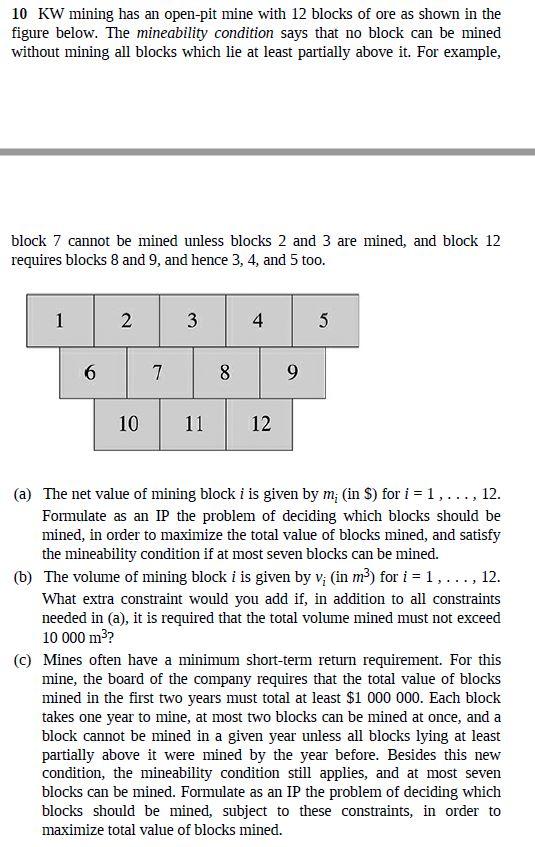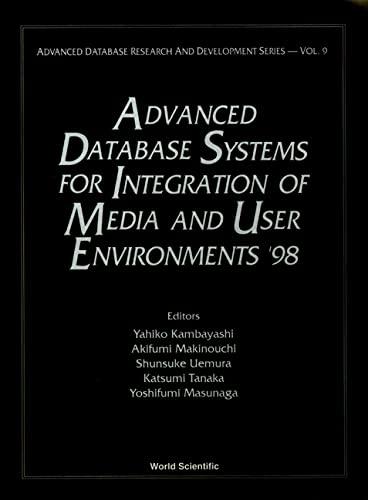Answered step by step
Verified Expert Solution
Question
1 Approved Answer
Please help with all parts of this Integer Programming problem. Thank you! 10 KW mining has an open-pit mine with 12 blocks of ore as

Please help with all parts of this Integer Programming problem. Thank you!
10 KW mining has an open-pit mine with 12 blocks of ore as shown in the figure below. The mineability condition says that no block can be mined without mining all blocks which lie at least partially above it. For example, block 7 cannot be mined unless blocks 2 and 3 are mined, and block 12 requires blocks 8 and 9, and hence 3, 4, and 5 too. 1 2 3 4 5 6 78 9 10 11 12 (a) The net value of mining block i is given by m; (in $) for i = 1,..., 12. Formulate as an IP the problem of deciding which blocks should be mined, in order to maximize the total value of blocks mined, and satisfy the mineability condition if at most seven blocks can be mined. (b) The volume of mining block i is given by v; (in m?) for i = 1, ..., 12. What extra constraint would you add if, in addition to all constraints needed in (a), it is required that the total volume mined must not exceed 10 000 m3? c) Mines often have a minimum short-term return requirement. For this mine, the board of the company requires that the total value of blocks mined in the first two years must total at least $1 000 000. Each block takes one year to mine, at most two blocks can be mined at once, and a block cannot be mined in a given year unless all blocks lying at least partially above it were mined by the year before. Besides this new condition, the mineability condition still applies, and at most seven blocks can be mined. Formulate as an IP the problem of deciding which blocks should be mined, subject to these constraints, in order to maximize total value of blocks mined. 10 KW mining has an open-pit mine with 12 blocks of ore as shown in the figure below. The mineability condition says that no block can be mined without mining all blocks which lie at least partially above it. For example, block 7 cannot be mined unless blocks 2 and 3 are mined, and block 12 requires blocks 8 and 9, and hence 3, 4, and 5 too. 1 2 3 4 5 6 78 9 10 11 12 (a) The net value of mining block i is given by m; (in $) for i = 1,..., 12. Formulate as an IP the problem of deciding which blocks should be mined, in order to maximize the total value of blocks mined, and satisfy the mineability condition if at most seven blocks can be mined. (b) The volume of mining block i is given by v; (in m?) for i = 1, ..., 12. What extra constraint would you add if, in addition to all constraints needed in (a), it is required that the total volume mined must not exceed 10 000 m3? c) Mines often have a minimum short-term return requirement. For this mine, the board of the company requires that the total value of blocks mined in the first two years must total at least $1 000 000. Each block takes one year to mine, at most two blocks can be mined at once, and a block cannot be mined in a given year unless all blocks lying at least partially above it were mined by the year before. Besides this new condition, the mineability condition still applies, and at most seven blocks can be mined. Formulate as an IP the problem of deciding which blocks should be mined, subject to these constraints, in order to maximize total value of blocks minedStep by Step Solution
There are 3 Steps involved in it
Step: 1

Get Instant Access to Expert-Tailored Solutions
See step-by-step solutions with expert insights and AI powered tools for academic success
Step: 2

Step: 3

Ace Your Homework with AI
Get the answers you need in no time with our AI-driven, step-by-step assistance
Get Started


